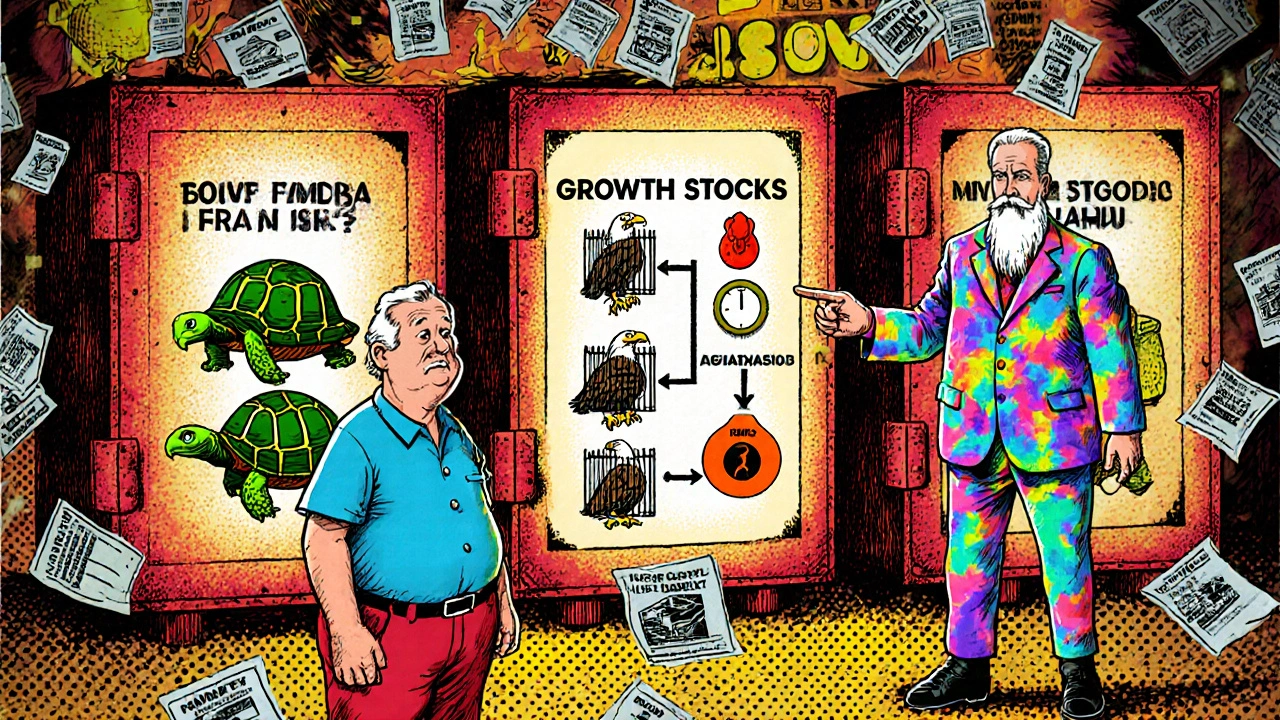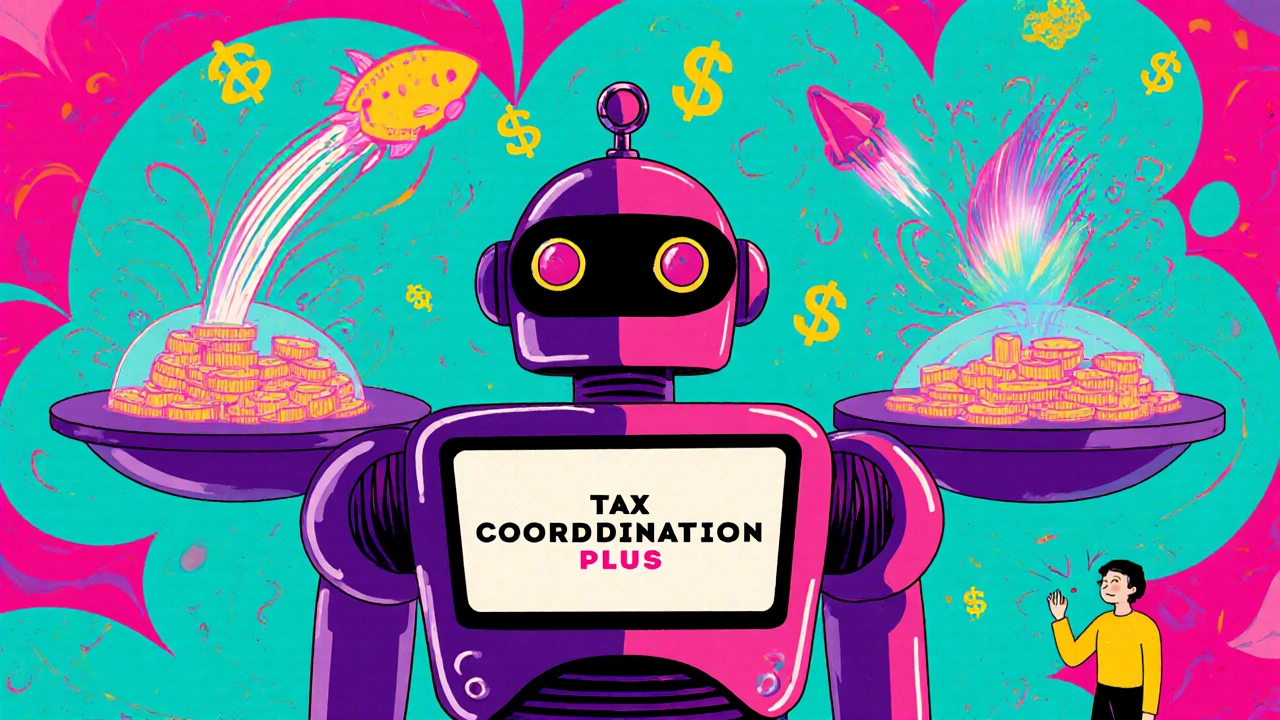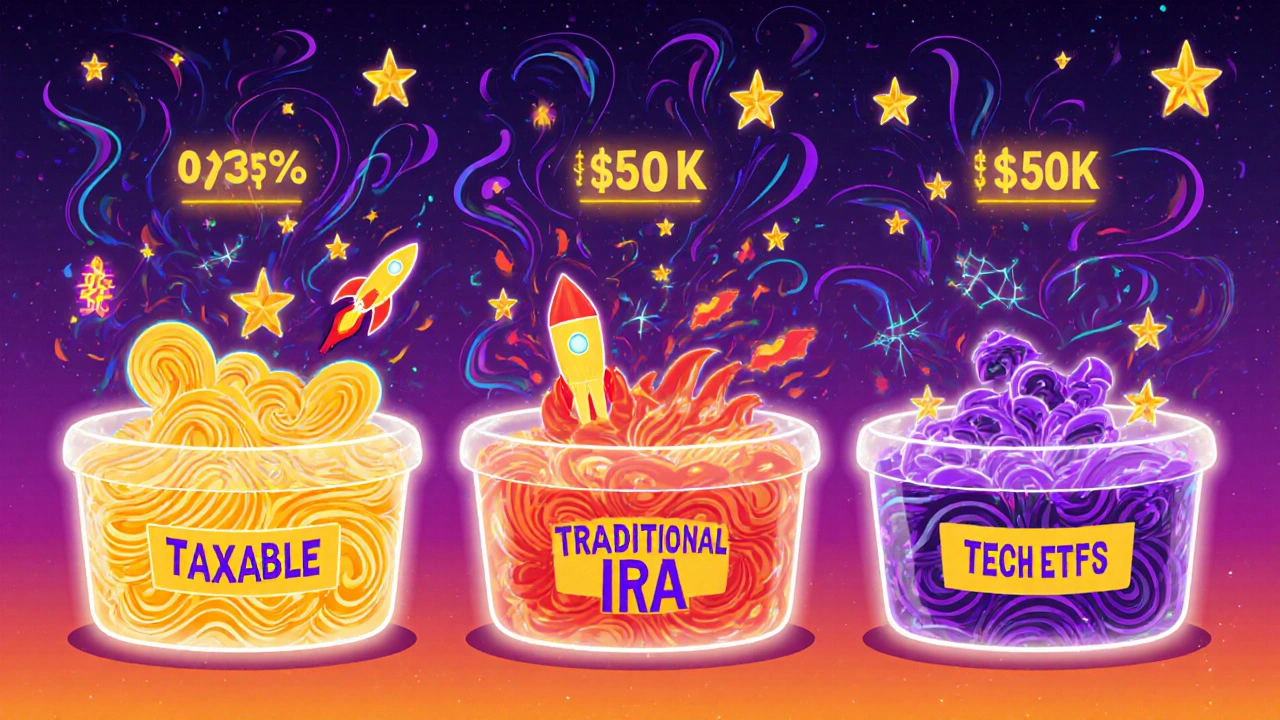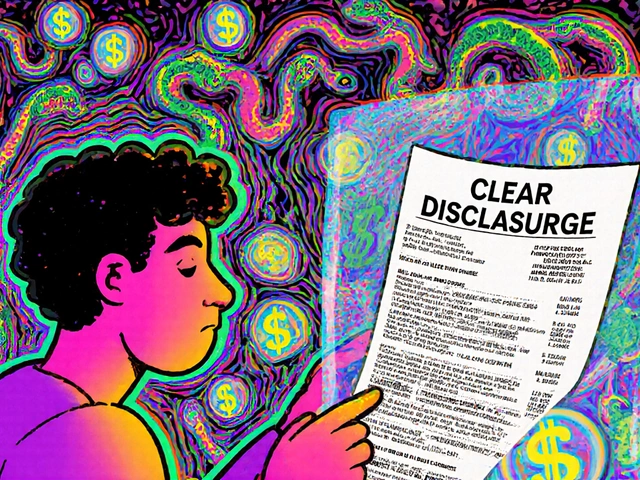Tax Efficiency Calculator for Retirement Accounts
Optimize Your Retirement Account Tax Efficiency
Calculate potential after-tax returns by strategically placing assets in taxable, Traditional IRA, 401(k), or Roth accounts.
Optimized Asset Location Results
Current Tax Treatment
Current After-Tax Return: 0.0%
Annual Tax Liability: $0
Optimized Tax Treatment
Optimized After-Tax Return: 0.0%
Annual Tax Liability: $0
Potential Savings
Potential Increase in After-Tax Returns: 0.0%
Potential Annual Savings: $0
25-Year Potential Savings: $0
Most people think retirement planning is just about saving more. But if you’ve got money spread across a taxable brokerage account, a Traditional IRA, and a 401(k), you’re already doing something most don’t: coordinating retirement accounts. And that makes all the difference. It’s not about how much you save-it’s about where you save it, and how you withdraw it later. Get this right, and you could boost your retirement income by 15% or more without taking on extra risk. Get it wrong, and you could be paying thousands in taxes you didn’t have to.
Why Your Accounts Need to Work Together
You wouldn’t put all your tools in one drawer and expect to build a house efficiently. Yet that’s exactly what most people do with their retirement money. A taxable account, a Traditional IRA, and a 401(k) each have different tax rules. When you treat them as separate silos, you miss out on powerful tax savings.The key is asset location-not asset allocation. Asset allocation is about how much you put in stocks vs bonds. Asset location is about which account holds which asset. For example, bonds generate interest income, which is taxed as ordinary income every year in a taxable account. That’s expensive. But in a Traditional IRA or 401(k), that interest grows tax-deferred. You pay taxes later, but not every year. That’s the win.
Meanwhile, growth stocks that rarely pay dividends and mostly appreciate over time are tax-efficient. They belong in taxable accounts because you only pay capital gains tax when you sell-and even then, only at 0%, 15%, or 20%, depending on your income. If you put those in a Roth IRA, you’re wasting the account’s biggest advantage: tax-free growth on high-return assets.
According to Betterment’s 2023 research, this simple shift can add 0.75% to your annual after-tax returns. That might sound small, but over 25 years, it can mean an extra $150,000 on a $500,000 portfolio. That’s not magic. It’s math.
How Each Account Is Taxed
Before you can coordinate, you need to know the rules. Each account has its own tax fingerprint.- taxable brokerage account: You pay taxes every year on dividends and capital gains. Long-term gains (held over a year) are taxed at 0%, 15%, or 20%. Dividends are taxed as either qualified (lower rate) or ordinary (higher rate). No contribution limits, no withdrawal rules.
- Traditional IRA and 401(k): Contributions reduce your taxable income today. Growth is tax-deferred. Withdrawals in retirement are taxed as ordinary income. For 2023, you can contribute up to $22,500 to a 401(k), plus $7,500 if you’re 50 or older. Traditional IRAs have the same limits, but income may limit your deduction if you have a workplace plan.
- Roth IRA and Roth 401(k): You pay taxes now, not later. Contributions don’t reduce your current tax bill, but qualified withdrawals-after age 59½ and five years since your first Roth contribution-are completely tax-free. Income limits apply: single filers phase out at $138,000, married at $218,000 (2023). No required minimum distributions (RMDs) for Roth IRAs.
Knowing this helps you match the right assets to the right accounts. High-tax assets go into tax-deferred or tax-free accounts. Low-tax assets go into taxable accounts.
Where to Put What: The Simple Rule
Here’s the practical version of what experts like William Reichenstein and David Blanchett recommend:- Put bonds and REITs in Traditional IRA or 401(k). These generate ordinary income. Tax-deferred accounts shield you from annual taxes on interest and distributions.
- Put growth stocks and ETFs in taxable accounts. They grow mostly through price appreciation, not dividends. You only pay capital gains tax when you sell-and often at a low rate.
- Put high-growth assets in Roth accounts. Think tech stocks, small-cap funds, or emerging market ETFs. The longer they grow, the more tax-free gains you accumulate. Roth accounts are perfect for assets with the highest long-term upside.
This isn’t theory. Vanguard’s 2021 study showed that investors with $500,000 across these accounts could increase their after-tax retirement income by 15-20% just by rearranging where their assets sat. The biggest gains? For people in the 24% or higher tax bracket.
But here’s the catch: you need to have all three account types. If you only have a 401(k), you can’t do this. If you’re just starting out and your portfolio is under $250,000, the benefits shrink. Fidelity found that below that threshold, the tax savings often get eaten up by trading costs or complexity.

Common Mistakes That Cost You Money
People think they’re doing fine because they’re contributing regularly. But small missteps add up.Mistake 1: Putting bonds in a Roth account. You’re giving up the chance to grow high-return assets tax-free. A bond fund that returns 4% a year isn’t worth the Roth’s tax-free potential. Save that for the 10%+ growth assets.
Mistake 2: Rolling over a 401(k) to a Traditional IRA without tracking after-tax contributions. If you made after-tax contributions in your 401(k)-like some employers allow-and you roll it into an IRA with pre-tax money, the IRS’s pro-rata rule kicks in. That means when you convert to a Roth later, you can’t just convert the after-tax portion. You’ll owe taxes on a portion of the conversion you didn’t expect. One Reddit user lost $12,000 this way.
Mistake 3: Ignoring RMDs. Starting at age 73 (thanks to SECURE Act 2.0), you must take required minimum distributions from Traditional IRAs and 401(k)s. RMDs from IRAs are calculated across all your IRAs-you can take the total from one account. But 401(k) RMDs must be taken from each plan separately. Miss one, and you pay a 50% penalty on the amount you didn’t take.
Mistake 4: Trying to manually rebalance across accounts. If you’re switching assets between accounts every quarter to keep your ideal allocation, you’re probably losing more in trading fees and taxes than you’re saving. Automation helps. Platforms like Betterment and Fidelity now offer tools that rebalance across your taxable, IRA, and 401(k) accounts automatically.
When Automation Makes Sense
You don’t need to be a tax expert to coordinate your accounts. Robo-advisors have made this accessible.Betterment launched its Tax Coordination feature in 2014. Today, it’s built into their platform. If you have a taxable account and an IRA, it automatically places bonds in your IRA and growth stocks in your taxable account. It even adjusts for tax-loss harvesting across both. Fidelity’s new “Tax Coordination Plus” (launched January 2024) now includes 401(k)s. That’s huge. Most tools only handle IRAs and taxable accounts. Now, if you’re still working and contributing to a 401(k), you can optimize across all three.
These tools don’t replace advice-they make it scalable. According to Schwab’s 2023 survey, only 37% of DIY investors coordinate their accounts properly. But 82% of financial advisors do. If you’re not using automation and you’ve got $500,000+ across accounts, you’re leaving money on the table.

What’s Changing in 2024 and Beyond
The rules aren’t static. The SECURE Act 2.0, passed in late 2022, changed a lot.- RMD age jumped from 72 to 73 in 2023, and will go to 75 in 2033.
- Starting in 2024, employer matching contributions to 401(k)s can be made as Roth contributions. That means your employer’s match could grow tax-free-if your plan allows it.
- The IRS is considering new aggregation rules that might let you combine RMDs from multiple employer 401(k) plans. That could simplify things for people who’ve worked at several companies.
But there’s risk. Some proposed tax reforms in 2024 aim to eliminate Roth conversions entirely. That would shut down a major strategy for high-income earners who want to move money from Traditional to Roth accounts. If you’re considering a Roth conversion, do it sooner rather than later.
What to Do Right Now
You don’t need to overhaul everything tomorrow. Start here:- List all your accounts. What’s in each? Taxable? Traditional IRA? Roth IRA? 401(k)?
- Identify your asset classes. Which holdings are bonds? REITs? Growth stocks? Dividend stocks?
- Use the simple rule. Move bonds and REITs into your Traditional IRA or 401(k). Keep growth stocks in taxable. Put high-growth assets in Roth.
- Check your RMDs. If you’re 73 or older, calculate your total IRA RMDs. Make sure you’re withdrawing enough from at least one IRA account.
- Consider automation. If you’re using a robo-advisor, turn on tax coordination. If you’re DIY, use a free tool like Personal Capital or Mint to track asset location across accounts.
Don’t wait for the perfect moment. The best time to coordinate your retirement accounts was years ago. The second-best time is now.






Comments
This is gold. I just moved my REITs from taxable to my IRA last month after reading this. My tax bill dropped by 40% last quarter. 😅
I appreciate how clearly this breaks down asset location. I used to think Roth was the "best" account for everything until I realized I was wasting its potential on bond funds. Now I keep my emerging market ETFs there and my dividend stocks in taxable. The math really adds up over time.
Also, thanks for flagging the pro-rata rule-my uncle lost thousands because he didn’t know about it. This kind of detail saves people from expensive mistakes.
OMG YES. I was doing ALL the wrong things until I turned on Fidelity’s Tax Coordination Plus. I had bonds sitting in my Roth like a total noob 😅 Now my growth stocks are in taxable, my REITs are tucked away in my 401(k), and my tech ETFs are in the Roth where they belong. My portfolio’s been humming like a Tesla on autopilot.
And FYI-my employer just started offering Roth matches. I’m maxing mine out. Tax-free employer cash? Sign me up. This is the future, folks. Stop leaving money on the table.
Let me be blunt: if you’re not coordinating your accounts and you’ve got over $500k across taxable, IRA, and 401(k), you’re not investing-you’re just parking money. The 15-20% boost isn’t theoretical. It’s mathematical, and it’s being exploited by every financial advisor with half a brain. The fact that 82% of advisors do this while only 37% of DIYers do? That’s not a gap. That’s a heist.
And don’t get me started on people rolling over 401(k)s without checking after-tax contributions. That’s not a mistake-that’s financial malpractice. One Reddit user lost $12k? I’ve seen people lose six figures. The IRS doesn’t care if you didn’t know. You’re responsible. Fix your accounts now or pay the price later. No more excuses.